Seat Ibiza ST 2010 Owner's manual
Manufacturer: SEAT, Model Year: 2010, Model line: Ibiza ST, Model: Seat Ibiza ST 2010Pages: 264, PDF Size: 7.11 MB
Page 231 of 264
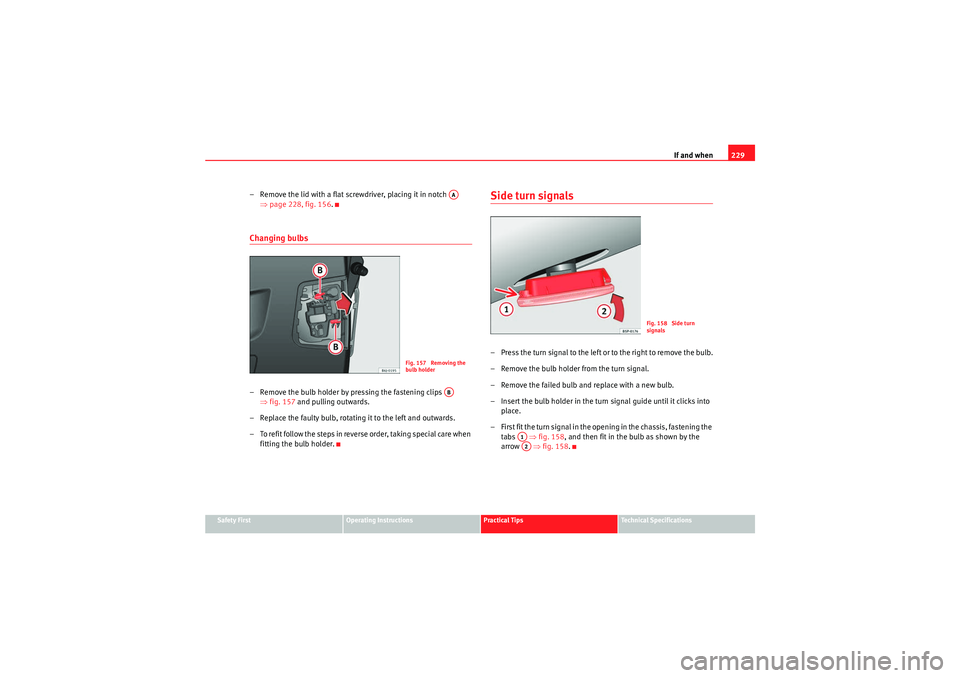
If and when229
Safety First
Operating Instructions
Practical Tips
Technical Specifications
– Remove the lid with a flat screwdriver, placing it in notch
⇒page 228, fig. 156 .Changing bulbs– Remove the bulb holder by pressing the fastening clips
⇒fig. 157 and pulling outwards.
– Replace the faulty bulb, rotating it to the left and outwards.
– To refit follow the steps in reverse order, taking special care when fitting the bulb holder.
Side turn signals– Press the turn signal to the left or to the right to remove the bulb.
– Remove the bulb holder from the turn signal.
– Remove the failed bulb and replace with a new bulb.
– Insert the bulb holder in the turn signal guide until it clicks into place.
– First fit the turn signal in the op ening in the chassis, fastening the
tabs ⇒fig. 158 , and then fit in the bulb as shown by the
arrow ⇒fig. 158 .
AA
Fig. 157 Removing the
bulb holder
AB
Fig. 158 Side turn
signals
A1A2
IbizaST_EN.book Seite 229 Dienstag, 14. September 2010 1:31 13
Page 232 of 264
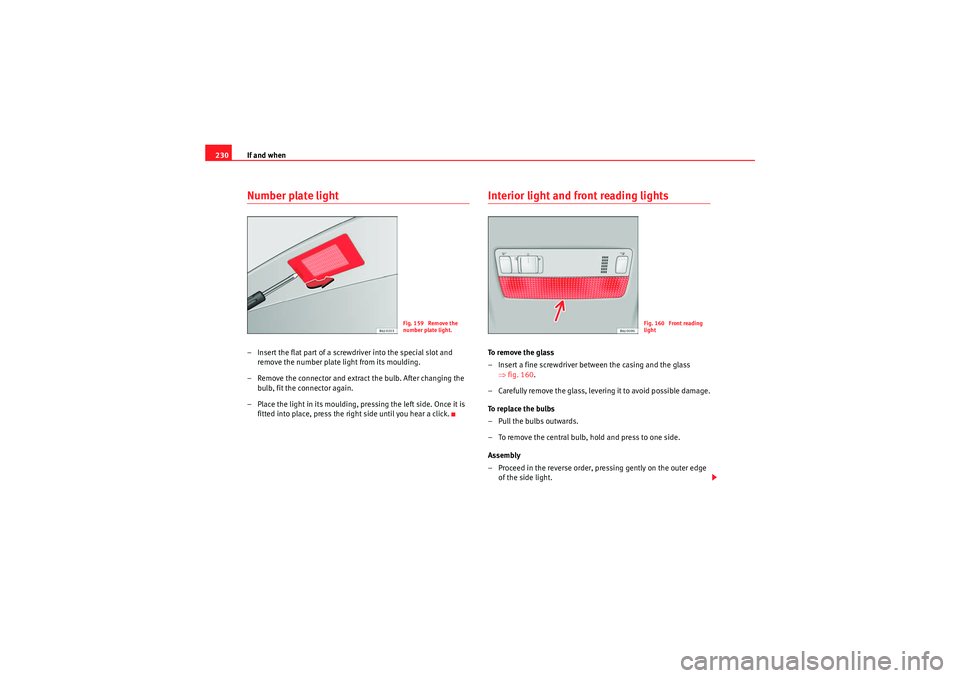
If and when
230Number plate light– Insert the flat part of a screwdriver into the special slot and
remove the number plate light from its moulding.
– Remove the connector and extract the bulb. After changing the bulb, fit the connector again.
– Place the light in its moulding, pressing the left side. Once it is fitted into place, press the right side until you hear a click.
Interior light and front reading lightsTo r e m o v e t h e g l a s s
– Insert a fine screwdriver between the casing and the glass ⇒fig. 160 .
– Carefully remove the glass, levering it to avoid possible damage.
To replace the bulbs
– Pull the bulbs outwards.
– To remove the central bulb, hold and press to one side.
Assembly
– Proceed in the reverse order, pressing gently on the outer edge of the side light.
Fig. 159 Remove the
number plate light.
Fig. 160 Front reading
light
IbizaST_EN.book Seite 230 Dienstag, 14. September 2010 1:31 13
Page 233 of 264
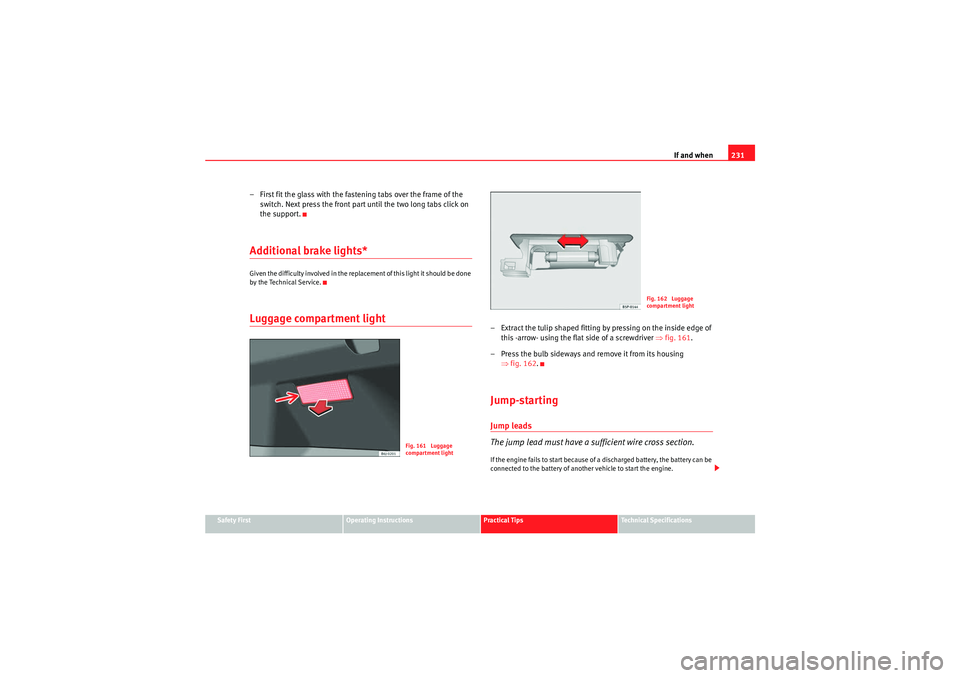
If and when231
Safety First
Operating Instructions
Practical Tips
Technical Specifications
– First fit the glass with the fastening tabs over the frame of the
switch. Next press the front part until the two long tabs click on
the support.Additional brake lights*Given the difficulty involved in the replacement of this light it should be done
by the Technical Service.Luggage compartment light
– Extract the tulip shaped fitting by pressing on the inside edge of this -arrow- using the flat side of a screwdriver ⇒fig. 161 .
– Press the bulb sideways and remove it from its housing
⇒ fig. 162 .Jump-startingJump leads
The jump lead must have a su fficient wire cross section.If the engine fails to start because of a discharged battery, the battery can be
connected to the battery of another vehicle to start the engine.
Fig. 161 Luggage
compartment light
Fig. 162 Luggage
compartment light
IbizaST_EN.book Seite 231 Dienstag, 14. September 2010 1:31 13
Page 234 of 264
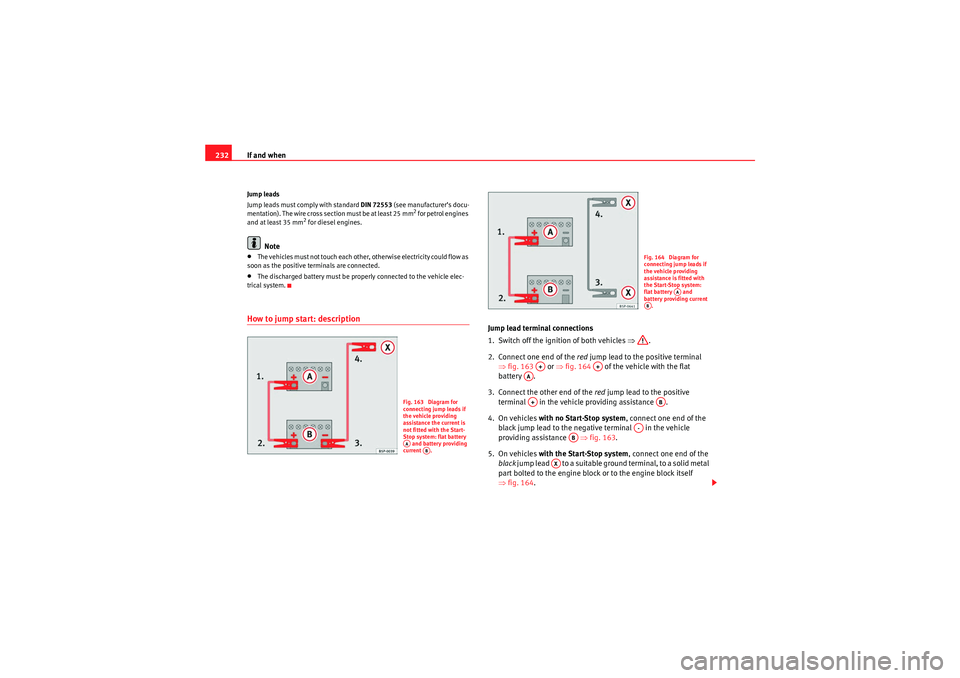
If and when
232Jump leads
Jump leads must comply with standard DIN 72553 (see manufacturer’s docu-
mentation). The wire cross section must be at least 25 mm
2 for petrol engines
and at least 35 mm
2 for diesel engines.
Note
•The vehicles must not touch each other, otherwise electricity could flow as
soon as the positive terminals are connected.•The discharged battery must be properly connected to the vehicle elec-
trical system.How to jump start: description
Jump lead terminal connections
1. Switch off the ignition of both vehicles ⇒.
2. Connect one end of the red jump lead to the positive terminal
⇒ fig. 163 or ⇒fig. 164 of the vehicle with the flat
battery .
3. Connect the other end of the red jump lead to the positive
terminal in the vehicle providing assistance .
4. On vehicles with no Start-Stop system , connect one end of the
black jump lead to the negative terminal in the vehicle
providing assistance ⇒fig. 163 .
5. On vehicles with the Start-Stop system , connect one end of the
black jump lead to a suitable ground terminal, to a solid metal
part bolted to the engine block or to the engine block itself
⇒ fig. 164 .
Fig. 163 Diagram for
connecting jump leads if
the vehicle providing
assistance the current is
not fitted with the Start-
Stop system: flat battery
and battery providing
current .AA
AB
Fig. 164 Diagram for
connecting jump leads if
the vehicle providing
assistance is fitted with
the Start-Stop system:
flat battery and
battery providing current .
AA
AB
A+
A+
AAA+
AB
A-
AB
AX
IbizaST_EN.book Seite 232 Dienstag, 14. September 2010 1:31 13
Page 235 of 264
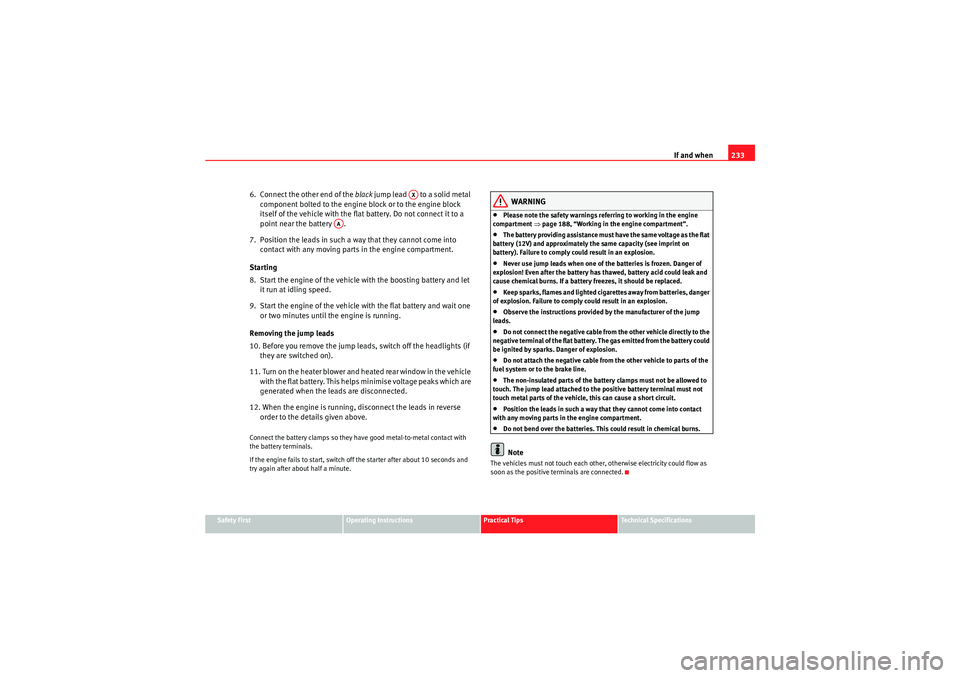
If and when233
Safety First
Operating Instructions
Practical Tips
Technical Specifications
6. Connect the other end of the black jump lead to a solid metal
component bolted to the engine block or to the engine block
itself of the vehicle with the flat battery. Do not connect it to a
point near the battery .
7. Position the leads in such a way that they cannot come into contact with any moving parts in the engine compartment.
Starting
8. Start the engine of the vehicle with the boosting battery and let it run at idling speed.
9. Start the engine of the vehicle with the flat battery and wait one or two minutes until the engine is running.
Removing the jump leads
10. Before you remove the jump leads, switch off the headlights (if they are switched on).
11. Turn on the heater blower and heated rear window in the vehicle with the flat battery. This helps minimise voltage peaks which are
generated when the leads are disconnected.
12. When the engine is running, disconnect the leads in reverse order to the details given above.Connect the battery clamps so they have good metal-to-metal contact with
the battery terminals.
If the engine fails to start, switch off the starter after about 10 seconds and
try again after about half a minute.
WARNING
•Please note the safety warnings referring to working in the engine
compartment ⇒page 188, “Working in the engine compartment”.•The battery providing assistance must have the same voltage as the flat
battery (12V) and approximately the same capacity (see imprint on
battery). Failure to comply could result in an explosion.•Never use jump leads when one of the batteries is frozen. Danger of
explosion! Even after the battery has thawed, battery acid could leak and
cause chemical burns. If a battery freezes, it should be replaced.•Keep sparks, flames and lighted cigarettes away from batteries, danger
of explosion. Failure to comply could result in an explosion.•Observe the instructions provided by the manufacturer of the jump
leads.•Do not connect the negative cable from the other vehicle directly to the
negative terminal of the flat battery. The gas emitted from the battery could
be ignited by sparks. Danger of explosion.•Do not attach the negative cable from the other vehicle to parts of the
fuel system or to the brake line.•The non-insulated parts of the battery clamps must not be allowed to
touch. The jump lead attached to the positive battery terminal must not
touch metal parts of the vehicle, this can cause a short circuit.•Position the leads in such a way that they cannot come into contact
with any moving parts in the engine compartment.•Do not bend over the batteries. This could result in chemical burns.Note
The vehicles must not touch each other, otherwise electricity could flow as
soon as the positive terminals are connected.
AX
AA
IbizaST_EN.book Seite 233 Dienstag, 14. September 2010 1:31 13
Page 236 of 264
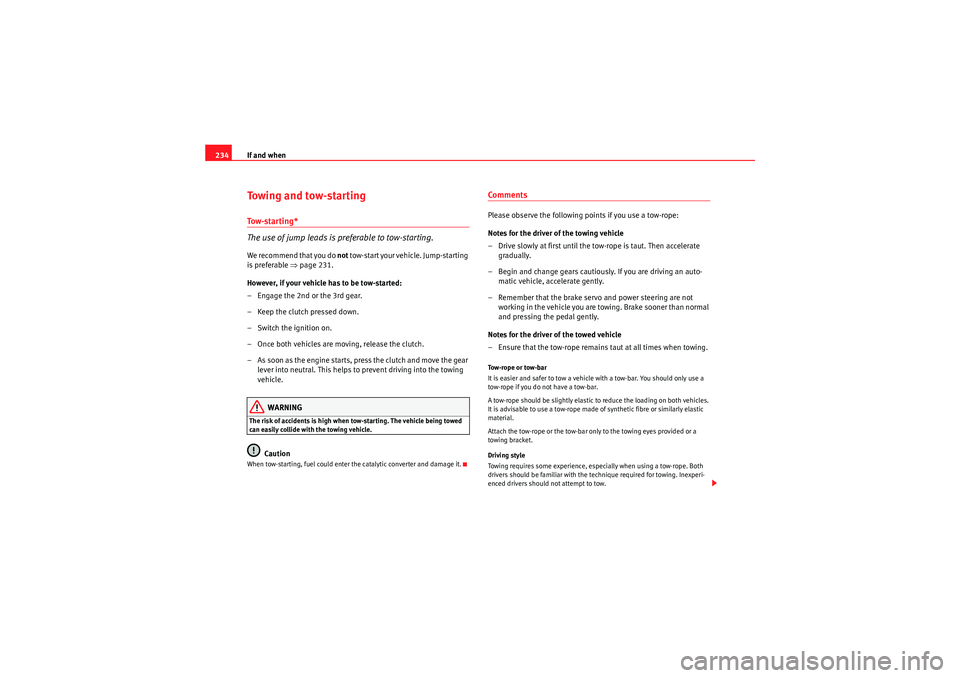
If and when
234Towing and tow-startingTo w - s t a r t i n g *
The use of jump leads is preferable to tow-starting.We recommend that you do not tow-start your vehicle. Jump-starting
is preferable ⇒ page 231.
However, if your vehicle has to be tow-started:
– Engage the 2nd or the 3rd gear.
– Keep the clutch pressed down.
– Switch the ignition on.
– Once both vehicles are moving, release the clutch.
– As soon as the engine starts, press the clutch and move the gear lever into neutral. This helps to prevent driving into the towing
vehicle.
WARNING
The risk of accidents is high when tow-starting. The vehicle being towed
can easily collide with the towing vehicle.
Caution
When tow-starting, fuel could enter the catalytic converter and damage it.
CommentsPlease observe the following points if you use a tow-rope:
Notes for the driver of the towing vehicle
– Drive slowly at first until the tow-rope is taut. Then accelerate gradually.
– Begin and change gears cautiously. If you are driving an auto- matic vehicle, accelerate gently.
– Remember that the brake servo and power steering are not working in the vehicle you are towing. Brake sooner than normal
and pressing the pedal gently.
Notes for the driver of the towed vehicle
– Ensure that the tow-rope remains taut at all times when towing.Tow-rope or tow-bar
It is easier and safer to tow a vehicle with a tow-bar. You should only use a
tow-rope if you do not have a tow-bar.
A tow-rope should be slightly elastic to reduce the loading on both vehicles.
It is advisable to use a tow-rope made of synthetic fibre or similarly elastic
material.
Attach the tow-rope or the tow-bar only to the towing eyes provided or a
towing bracket.
Driving style
Towing requires some experience, especially when using a tow-rope. Both
drivers should be familiar with the technique required for towing. Inexperi-
enced drivers should not attempt to tow.
IbizaST_EN.book Seite 234 Dienstag, 14. September 2010 1:31 13
Page 237 of 264
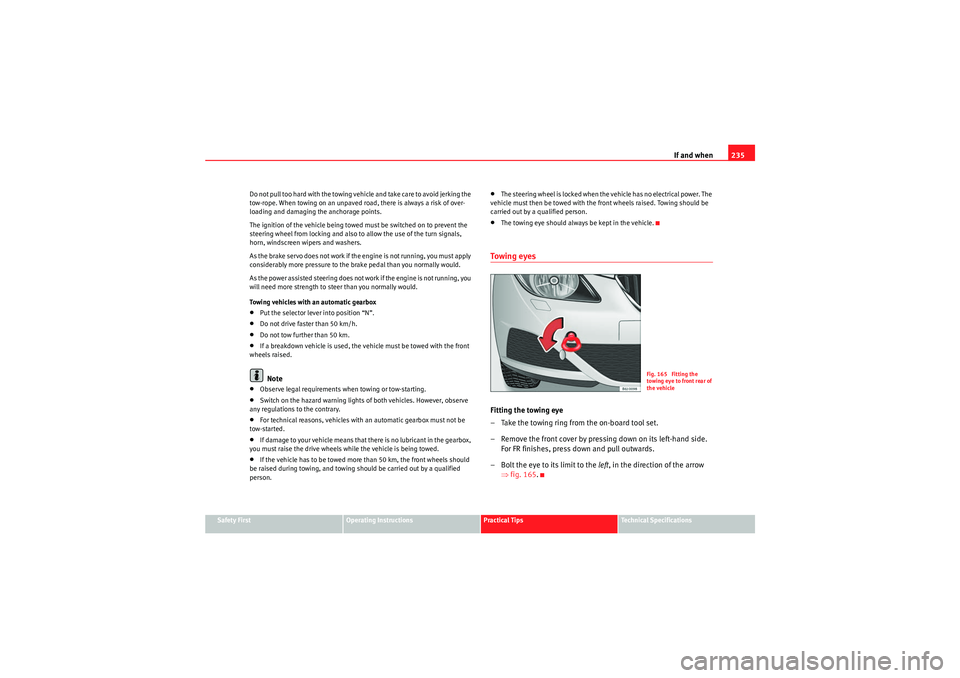
If and when235
Safety First
Operating Instructions
Practical Tips
Technical Specifications
Do not pull too hard with the towing vehicle and take care to avoid jerking the
tow-rope. When towing on an unpaved road, there is always a risk of over-
loading and damaging the anchorage points.
The ignition of the vehicle being towed must be switched on to prevent the
steering wheel from locking and also to allow the use of the turn signals,
horn, windscreen wipers and washers.
As the brake servo does not work if the engine is not running, you must apply
considerably more pressure to the brake pedal than you normally would.
As the power assisted steering does not work if the engine is not running, you
will need more strength to steer than you normally would.
Towing vehicles with an automatic gearbox
•Put the selector lever into position “N”.•Do not drive faster than 50 km/h.•Do not tow further than 50 km.•If a breakdown vehicle is used, the vehicle must be towed with the front
wheels raised.Note
•Observe legal requirements when towing or tow-starting.•Switch on the hazard warning lights of both vehicles. However, observe
any regulations to the contrary.•For technical reasons, vehicles with an automatic gearbox must not be
tow-started.•If damage to your vehicle means that there is no lubricant in the gearbox,
you must raise the drive wheels while the vehicle is being towed.•If the vehicle has to be towed more than 50 km, the front wheels should
be raised during towing, and towing should be carried out by a qualified
person.
•The steering wheel is locked when the vehicle has no electrical power. The
vehicle must then be towed with the front wheels raised. Towing should be
carried out by a qualified person.•The towing eye should always be kept in the vehicle.To w i n g e y e sFitting the towing eye
– Take the towing ring from the on-board tool set.
– Remove the front cover by pressing down on its left-hand side. For FR finishes, press down and pull outwards.
– Bolt the eye to its limit to the left, in the direction of the arrow
⇒ fig. 165 .
Fig. 165 Fitting the
towing eye to front rear of
the vehicle
IbizaST_EN.book Seite 235 Dienstag, 14. September 2010 1:31 13
Page 238 of 264
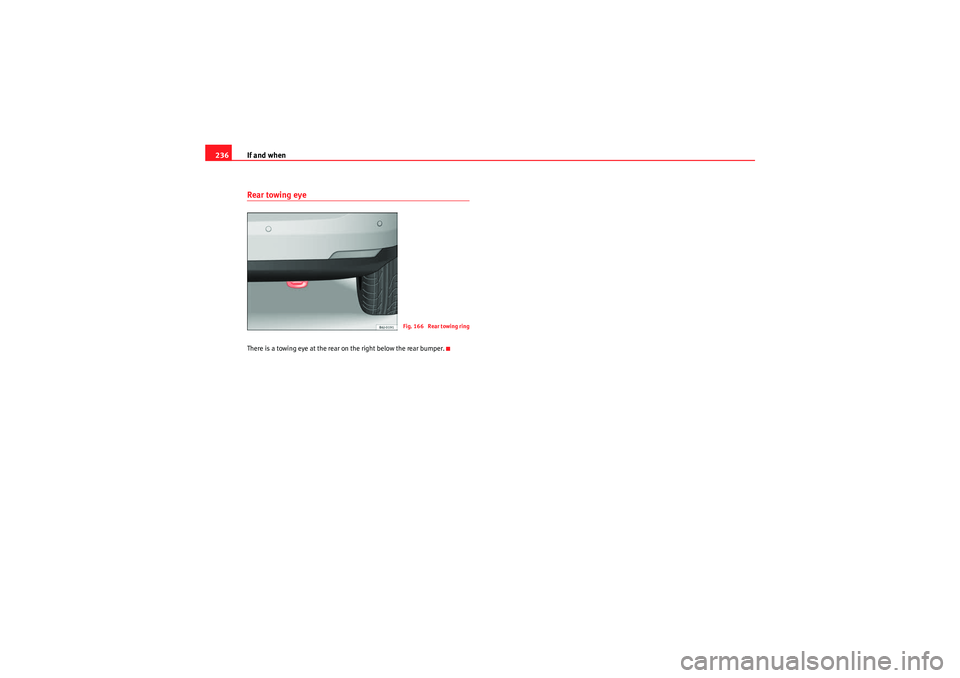
If and when
236Rear towing eyeThere is a towing eye at the rear on the right below the rear bumper.
Fig. 166 Rear towing ring
IbizaST_EN.book Seite 236 Dienstag, 14. September 2010 1:31 13
Page 239 of 264
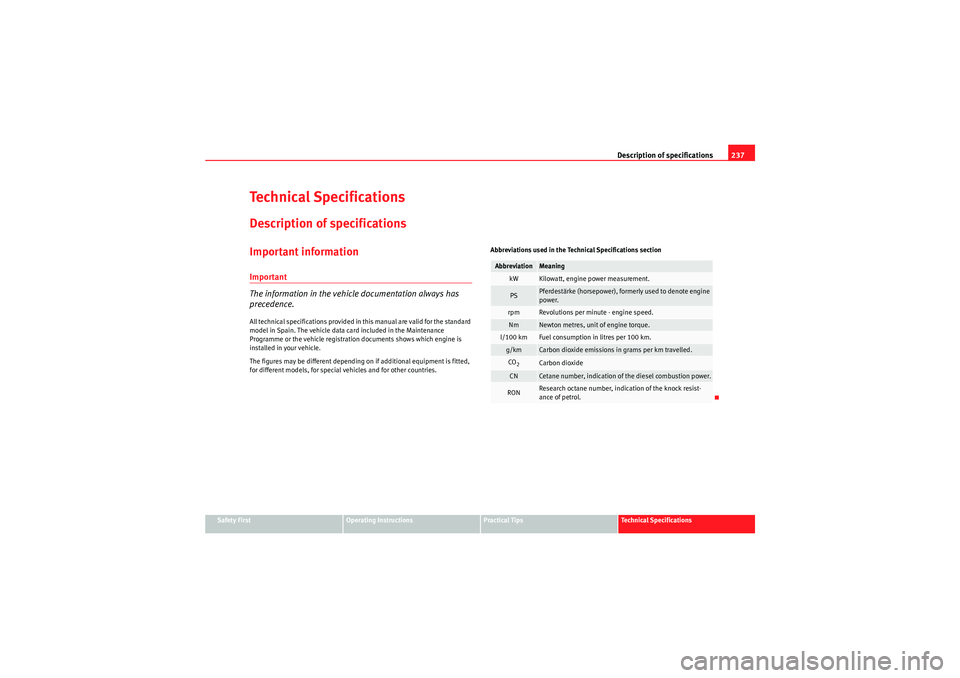
Description of specifications237
Safety First
Operating Instructions
Practical Tips
Technical Specifications
Technical SpecificationsDescription of specificationsImportant informationImportant
The information in the vehicle documentation always has
precedence.All technical specifications provided in this manual are valid for the standard
model in Spain. The vehicle data card included in the Maintenance
Programme or the vehicle registration documents shows which engine is
installed in your vehicle.
The figures may be different depending on if additional equipment is fitted,
for different models, for special vehicles and for other countries. Abbreviations used in the Technical Specifications section
Abbreviation
Meaning
kW
Kilowatt, engine power measurement.
PS
Pferdestärke (horsepower), formerly used to denote engine
power.
rpm
Revolutions per minute - engine speed.
Nm
Newton metres, unit of engine torque.
l/100 km
Fuel consumption in litres per 100 km.
g/km
Carbon dioxide emissions in grams per km travelled.
CO2
Carbon dioxide
CN
Cetane number, indication of the diesel combustion power.
RON
Research octane number, indication of the knock resist-
ance of petrol.
IbizaST_EN.book Seite 237 Dienstag, 14. September 2010 1:31 13
Page 240 of 264
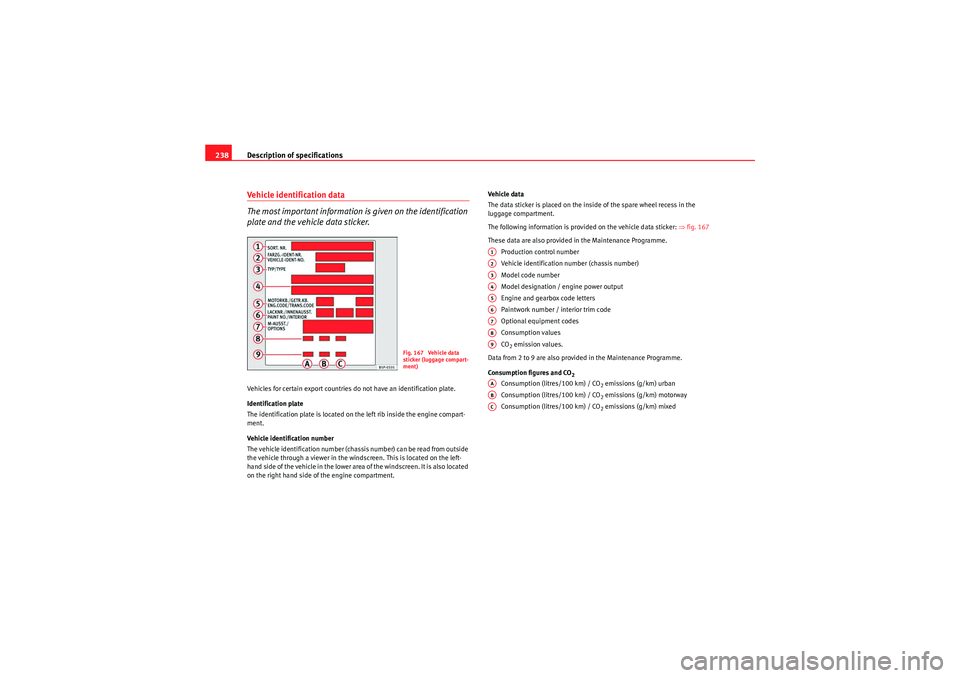
Description of specifications
238Vehicle identification data
The most important information is given on the identification
plate and the vehicle data sticker.Vehicles for certain export countries do not have an identification plate.
Identification plate
The identification plate is located on the left rib inside the engine compart-
ment.
Vehicle identification number
The vehicle identification number (chassis number) can be read from outside
the vehicle through a viewer in the windscreen. This is located on the left-
hand side of the vehicle in the lower area of the windscreen. It is also located
on the right hand side of the engine compartment. Vehicle data
The data sticker is placed on the inside of the spare wheel recess in the
luggage compartment.
The following information is provided on the vehicle data sticker:
⇒fig. 167
These data are also provided in the Maintenance Programme. Production control number
Vehicle identification number (chassis number)
Model code number
Model designation / engine power output
Engine and gearbox code letters
Paintwork number / interior trim code
Optional equipment codes
Consumption values
CO
2 emission values.
Data from 2 to 9 are also provided in the Maintenance Programme.
Consumption figures and CO
2
Consumption (litres/100 km) / CO
2 emissions (g/km) urban
Consumption (litres/100 km) / CO2 emissions (g/km) motorway
Consumption (litres/100 km) / CO2 emissions (g/km) mixed
Fig. 167 Vehicle data
sticker (luggage compart-
ment)
A1A2A3A4A5A6A7A8A9AAABAC
IbizaST_EN.book Seite 238 Dienstag, 14. September 2010 1:31 13